How To Add Comments In Track Changes
How comments in Word work
Acquire how to add comments in Word, how to remove comments in Word, print without comments, change font size of comments, etc.
In Word, you can use comments to add notes to the document content. Comments are saved with the certificate and travel with the document if you share it with others. Comments are particularly useful in the editing and reviewing process of a Discussion document. Unlike people can add together comments and answer to other people's comments. When finished, all comments can easily be deleted.
Word has a number of congenital-in tools defended to comments. In this article, you will learn how comments in Word work and how to use the comment tools. The basic information about comments applies to both the congenital-in comment functionality and the functionality of the DocTools CommentManager add-in.
The information in this article applies to Word 2013, Word 2016, Word 2019, Word 2021, and Word for Microsoft 365 on PC/Windows. Part of the information in this article besides applies to Word 2010 and earlier versions but the comment tools and the means to access them differ.
Of import: If your version of Give-and-take for Microsoft 365 has changed toModern Comments (run across below), the information in this article does non apply in total.
About Microsoft'south recent change to Modernistic Comments in Microsoft 365
I added this data about Modern Comments in May 2021. Since then, Microsoft has implemented a much requested feature for turning off Modernistic Comments .
If you are using Word for Microsoft 365, you may have experienced that the comment features in Word accept inverse recently. Microsoft has introduced what they call Mod Comments. Modern Comments work quite differently than comments in Word have been working for years.
Mod Comments accept not been rolled out to all users yet. Personally, I had to install the Insider Betaversion of Function on a calculator to get admission to Modern Comments and then I could test it. Close to the end of 2021, I withal exercise non run across Modernistic Comments in my version of Microsoft 365.
The switch to Modern Comments has frustrated many users and made many users aroused. I agree with those users. I hope Microsoft will listen to the users and either implement an option to utilise the old comment features (Classic Comments) or set all the many bug that have been reported with Modern Comments. You tin read about Modern Comments and come across a lot of user comments in the Microsoft article Introducing Modernistic Comments in Microsoft Word.
In this article, I link to my DocTools CommentManager add-in in relation to specific features. Unfortunately, I experienced that many features in the add-in didn't work with Modern Comments. Every bit of 20-Jun-2021, I accept released DocTools CommentManager 3.0 that works with both classic comments and Modern Comments.
As explained to a higher place, the information in this commodity covers the comment features as they worked before Modern Comments.
How to turn off Modern Comments and become the old comment features back
Microsoft has added a temporary selection in Discussion for Microsoft 365 that lets you revert to the erstwhile comment features. To practise so:
- Select File > Options > General > plow OFF the Enable modern comments bank check box.
This will temporarily revert to the old comment features. Microsoft plans to remove this choice after. The change of the setting does not take effect until you have restarted Word.
The DocTools CommentManager add-in makes information technology faster and easier to manage comments in Word. In addition, the add-in lets you review comments in Word from ane place, rank comments by importance, extract all comments to either Word or Excel, create inline comments for instructions and help, etc. DocTools CommentManager add-in is completely compatible with Word'south own annotate features.
Where to find the annotate tools in Give-and-take
You lot volition find the dedicated comment tools on the Review tab in the Ribbon.
- The Comments group on the Review tab includes tools that are dedicated to comments.
- The Tracking group on the Review tab includes tools that are used both in relation to comments and tracked changed. In this grouping, you volition notice tools to employ for changing how comments are displayed.

Figure 1.The congenital-in comment tools in Word are found on the Review tab.
How to add comments in Word
Discussion lets you add together two levels of comments. Outset-level comments and replies to first-level comments.
You can add offset-level comments in Discussion either via commands in the Ribbon or past using a keyboard shortcut. To can add together a answer to a comment directly from the comment. Read on below.
How to insert a comment in Discussion
Give-and-take lets you lot view documents in a number of ways. In relation to comments, Print Layout view gives you the all-time overview. You lot tin, for example, switch view from View tab in the Ribbon > Views group. You can also pressAlt+Ctrl+P to switch toPrint Layoutview.
The born functionality in Word lets yous add/insert comments from two different places. To insert a comment in Word:
- Select the text you want to comment.
The selected text will exist marked as the comment scope. If no text is selected, Word will mark the preceding word, if any, as the comment scope.
To make information technology every bit easy for other users to understand your annotate, make sure to select precisely the text that the comment refers to instead of, for instance, selecting entire paragraphs.
- Follow step 2a, 2b, or 2c:
a. Select the Review tab in the Ribbon > Comments group > New Comment
OR
b. Select the Insert tab in the Ribbon > Comments group > Comment
OR
c. Press the keyboard shortcutAlt+Ctrl+M.The inserted annotate appears in the markup surface area (or balloon surface area) in the margin or in the Reviewing Pane depending on your settings for display of comments. See How to evidence comments in Give-and-take below. Encounter Figure 2 below.
- In the inserted annotate, type the comment text.
- When finished, press theEsc key to return to the certificate text or click in the document.
Notation that pressingEsc will select the text you marked in pace 1 above. If you haveDocTools CommentManager, pressingEsc volition position the insertion indicate after the scope you selected, ready for yous to go on typing without first deselecting the comment scope.
If you lot are using the DocTools CommentManager add-in, you can insert comments via DocTools tab > CommentManager grouping > Insert Comment .
Notation: Comments in Discussion are stored in the documents. A comment tin can exist edited by anyone who has access to edit the document and not but by the original author who inserted the comment.

Figure 2. A new comment has only been added, set up for typing annotate text. Note that ifSimple Markup is selected in the Tracking group on the Review tab, the commented text (annotate scope) volition merely be marked by a color when you have selected the comment in the markup area. If your document is inTyphoon view instead ofPrint Layout view, the annotate will appear in theReviewing Pane.

Figure 3. By default, Word shows pictures by comments. You tin can turn off the pictures.
NOTE: By default, Give-and-take shows pictures by comments in the balloon expanse. You tin toggle off/on the pictures by correct-clicking in a annotate and selecting Hide Pictures past Comments (will modify the label toShow Pictures past Comments).
Pictures are turned off in all the following illustrations in this article. They have upward space in the comments and are most likely without importance for most users.
How to add a comment as a reply to another annotate
Word lets you add together ii levels of comments. First-level comments and replies to beginning-level comments.
To add a reply to an existing comment:
- Click in the comment text of the comment yous are going to reply to.
- Click theReply icon below the comment text (See Figure 5 below).
OR
Right-click in the comment and selectRespond to Comment. - In the inserted comment reply, type the annotate text.
- When finished, press theEsc primal to return to the certificate text or click in the document.
Replies to comments are indented below the comment to which they belong. You can add more replies to the aforementioned comment. All replies will appear on the aforementioned level – they will all be shown as replies to the first-level comment even if a answer is actually written as a respond to some other reply.

Effigy 5A. Click the Answer icon to add a reply to an existing comment.
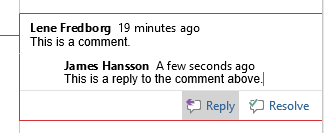
Figure 5B. A new annotate has been added as a reply to an existing comment.
If a folio has also many comments for Word to have room for all the comment text, the comments will exist collapsed. A comment will expand when y'all click the annotate.
Note that Discussion 2013 and afterward versions do non number comments when shown in the balloon area/Comments pane. Only if you view comments and revisions inline or in the Reviewing pane, or if you switch to Draft view or Outline view, numbers are shown together with the writer initials. Syntax for comments numbers shown inline: NN#, where NN are the initials and # the index number of the comment, counted from the start of the document. Case: LF5. Yous volition not exist able to see on the number whether a comment is a first-level comment or a reply to some other comment.
TheDocTools CommentManageradd-in shows the actual comment number and total number of comments in the Status Bar when you apply the Previous Comment orNext Annotate commands.
How to edit a annotate in Word
To edit an existing comment in Give-and-take:
- Make certain the comment is shown. Meet How to show comments in Word.
- Click in the comment and add together, delete, or change the annotate text.
How to resolve a comment in Word
Word lets y'all mark a annotate every bit resolved. This volition change the font colour(s) of the comments to a stake expect. Marking comments as resolved may aid you keep track of which comments still need attention.
To mark a comment as resolved:
- Click in the annotate text of the comment you lot are going to mark as resolved.
- Click theResolveicon below the annotate text (see Effigy 5 above).
OR
Right-click in the annotate and selectResolve Comment.
The Resolve icon changes to Reopen. If needed, you can plow off the resolved condition again past clicking Reopen or by right-clicking in the comment and selecting Reopen Comment.
Why can't I resolve comments in Word?
Yous may experience that the Resolveicon and the Resolve Comment command are grayed out, indicating that the commands are disabled and cannot exist used. To find out why this happens and how to solve it, read on below.
What to do if the Resolve icon is grayed out – and what causes the problem?
The Resolvefeature was introduced in Discussion 2013. The Resolve characteristic is grayed out under the following weather:
- The certificate was created in or last saved in Discussion 2010 or an earlier version.
- The document is in compatibility mode.
If the certificate is in compatibility mode, newer Word features cannot be used. You will see the text (Compatibility Way) later on the file name in the Title bar of the Discussion window.
How to solve the problem
You can convert the document to allow all features in you Word version to exist bachelor. Apply one of the post-obit methods to update the document to your version of Word. This will enable the Resolve characteristic:
- METHOD one: Select File > Info > click Convert. Save the document.
- METHOD 2: Select Relieve As (F12). In the Save Asdialog box, plow off the pick Maintain compatibility with previous versions of Word. ClickSave. Come across the illustration below.
Important: Conversion of a document may outcome in changes to the formatting of the certificate, depending how information technology was set upwardly. For examples, the widths of tables created in Word 2010 and earlier may change when converted to Discussion 2013 format or later (due to changes of how cell margins are handled).
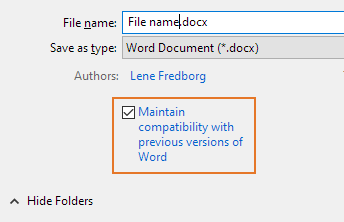
Bottom-left function of Salve As dialog box - turn off Maintain compatibility with previous versions of Word to convert the document to your version of Word. This allows newer features to be used.
How to remove resolved comments in Word
Word does not take a built-in feature for removing all resolved comments in one operation. Y'all demand to go through all the resolved comments and delete them i past one.
Note that the DocTools CommentManageradd together-in lets y'all delete all resolved comments with the click of a push. For details, see How to delete resolved comments in Give-and-take.
Where does the name in an inserted Discussion comment come up from?
The authorname shown in an inserted annotate is the proper name currently specified for the user in File > Options > Full general > User Name. Run across Figure 4B below.
If yous take selected to show comments and revisions inline in the document, Word shows initials in the comment reference. The initials are the ones currently specified for the user in File > Options > General > Initials. Run across Figure 4B below.
You can besides become access to the user name and initials via the Track Changes Options dialog box. To open that dialog box, click the pocket-size arrow (dialog box launcher) in the bottom-right corner of Review tab > Tracking group.
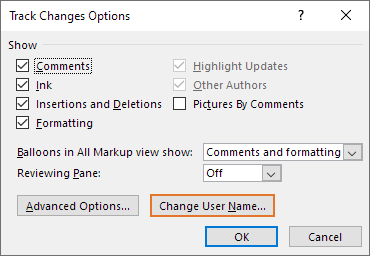
Figure 4A. You can become admission to the user proper noun and initials settings via the Alter User Name button in the Track Changes Options dialog box. See the analogy beneath.
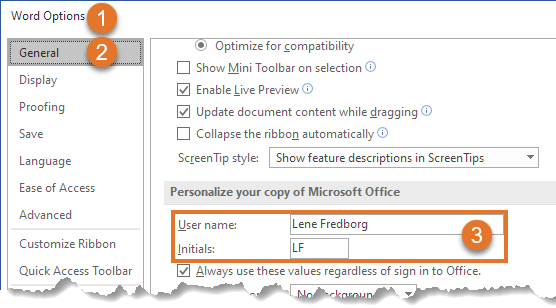
Figure 4B. The User Nameand Initialssettings in Discussion Options > General.
If you alter the user name and initials, the new values will exist used in new comments you add. It will not change the proper name and initials in existing comments.
The currently defined user name and initials are too used in insertions, deletions, and formatting changes fabricated while rails changes is turned on.
How to remove name from comments in word
Give-and-take's annotate functionality does not include functionality for changing the writer proper name of existing comments. Notwithstanding, Discussion lets y'all remove personal data which will set the writer proper noun of all comments to "Author". Run across How to remove personal data from comments. Run into besides the macro solution afterward in this article.
Annotation that the DocTools CommentManager add-in lets you easily change the user name and initials, also in existing comments. The control Change Author Names in Existing Comments lets you change all names or but a specific name of your choice. For case, this feature tin be used to change author names to the company proper noun before sharing a document with external people or to right a misspelled or otherwise wrong user proper noun. If you want to remove the name from comments, y'all can use the command to set the name to e.g. a non-breaking space (Ctrl+Shift+Spacebar), a hyphen or an En dash. Run into as well the data beneath near a feature in the DocTools ExtractChanges Pro add-in that lets you do even more and that handles both tracked changes and comments.
The DocTools ExtractChanges Pro add-in (from version 6.0) includes a control,Modify Author & Date, that lets y'all change the proper noun in existing tracked changes and comments. In addition, the command lets y'all remove or modify the date of the tracked changes and comments. You can select whether the proper noun and/or date changes are to be applied to all tracked changes and comments or just tracked changes and comments added by a specific author. The changes are fabricated in copy of the document so that the original document remains unchanged.
TIP: If you want to remove the name from tracked changes and comments, you lot can type e.g. a non-breaking space (Ctrl+Shift+Spacebar), a hyphen or an En nuance as both the writer name and initials in the Change Author & Date dialog box in DocTools ExtractChanges Pro.
How do dates in Word comments work?
Word shows date and time information on a comment in the following situations:
- When a annotate is selected in the balloon area
- When you hover the mouse over a annotate in the balloon surface area
- When y'all hover the mouse over a comment mark on a page if no balloons are shown
- Above each annotate in the Reviewing Pane
The date and time tell when the annotate was added.
Is it possible to change the date of a comment in Word?
The date assigned to a annotate in Word cannot be changed. Also, you cannot change the way that engagement and time information is shown. See below for details.
Language of date and time information in comments
The language used for appointment and fourth dimension information in balloons is determined by the current language of the user interface in Word, i.e. the language used in Ribbon, dialog boxes, etc. This also means that weekdays and month names are written in the language of the user interface. If yous change that language, the date and fourth dimension data will automatically change likewise.
The date format shown in balloons seems to e'er follow English (US) syntax no affair the linguistic communication and even if it is not a normal date syntax in the actual linguistic communication:
- [month name] [day], [year]
Instance: March 21, 2018
Nearly comment date and time information shown in the balloon area
The date and time data for comments in the balloons is not always given as date and time – you will come across text descriptions instead. As time goes, the date and time information for a comment in the balloon area will modify. The data shown follows the order described below – text shown equally y'all volition run across it in English versions of Word:
First 24 hours
A few seconds ago
2 minutes ago
3 minutes agone
…
59 minutes ago
60 minutes ago
ane hour agone
2 hours ago
…
23 hours agone
24 hours ago
Next six days
Yesterday
The next days, until 1 calendar week after adding the comment: the actual weekday, e.g. Midweek, Th. Weekday names seem to be shown in the language set in the regional settings in Windows.
Afterward a week
Subsequently a week, the information will change to showing date and time in the following format:
[calendar month name] [day], [year] hh:mm:ss
where:
hh = hours
mm = minutes
ss = seconds
You may run across time given with AM/PM values.
Every bit explained to a higher place, the calendar month proper name volition be in the language of the user interface and the syntax follows English (U.s.a.) rules fifty-fifty if not in English:
Examples:
- English user interface: March 21, 2019 xiv:55:35
- German user interface: März 21, 2019 14:55:35
- Danish user interface: marts 21, 2019 fourteen:55:35
TheCommentManager add-in makes it fast and piece of cake to get an overview of all comments in a Word document, using theReview Comments command. This also includes date and fourth dimension information.
How to show comments in Discussion
Comments in Discussion tin be displayed in different ways:
- In balloons (see OPTION i below)
- In the Reviewing Pane (see OPTION ii below)
- In screen tips simply (see OPTION 3 beneath)
Pick 1 – How to show comments in balloons
The certificate must be inImpress Layout view (Alt+Ctrl+P) to bear witness comments in balloons.
- Select the Review tab in the Ribbon.
- In the Tracking group, click Show Markup > Balloons and select Bear witness Revisions in Balloons or Show Merely Comments and Formatting in Balloons equally desired. See Figure half dozen below.
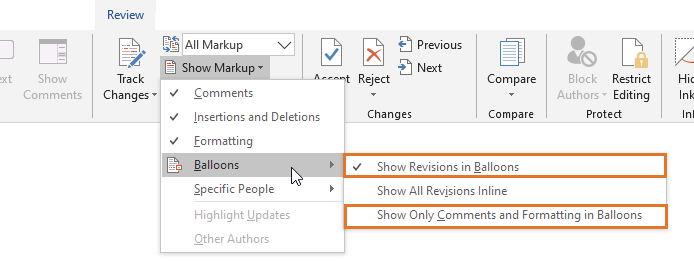
Figure six. How to testify comments in balloons in Word. Select one of the options marked by colored frame.

Figure vii. TheMarkup Area or Balloon Area is shown in the left or right margin depending on your settings. You tin modify the position and width of the balloon expanse via the Advanced Rail Changes Options dialog box.
Pick 2 – How to show comments in the Reviewing Pane
Yous tin can show theReviewing Pane in any view except Read Mode.
- Select the Review tab in the Ribbon.
- In the Tracking group, click Reviewing Pane.
- From the carte du jour, selectReviewing Pane Vertical orReviewing Pane Horizontal depending on how you desire the pane to be shown.
You tin shut the Reviewing Pane again by clicking the X in top-right corner of the pane.
OPTION iii – How to evidence comments in screen tips
To use this method, all revisions must exist shown inline. This means that the following option must be selected: Review tab > Tracking group > Show Markup > Balloons > Evidence All Revisions Inline. Run across the second option in Effigy six above.
- Hover the mouse over a comment reference, i.east. the initials and number shown where a comment has been inserted.
- A screen tip will appear, showing the comment text. See Figure 8 below.
NOTE: If no screen tip appears when yous hover the mouse over the comment reference, endeavor to motion the mouse a flake. If the screen tip does not appear, the problem is most probable that display of screen tips is turned off. To turn information technology on, select File > Options > Display > plough on Testify document tooltips on hover.
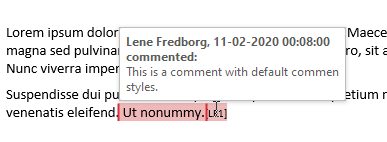
Figure viii. Example of comment shown as a screen tip when hovering the mouse over a comment reference in Discussion.
TheDocTools CommentManager add-in includes special tools that brand it faster to work with comments. For case, the Review Comments control opens a dialog box that works as a control middle from where you can view, edit, delete, search comments and more.
How to bear witness only specific comments in Word
Show comments by a specific author only
In Give-and-take documents with many comments, it may sometimes be helpful to come across simply a subset of the comments. Word lets you show/hide comments by author.
To evidence only comments added by a specific author:
- Select Review tab > Tracking group > Testify Markup > Specific People: Deselect all authors except the author(due south) whose comments y'all want to see.
This does not remove whatsoever comments – it just hides some comments temporarily.
How to hide resolved comments in Word
When you utilise Word'south Resolve characteristic in a comment, the comment is marked as resolved and shown dimmed. Still, the annotate remains in the certificate until you delete it.
You may be interested in keeping the resolved comments in the document until all comments have been handled. Notwithstanding, you may desire to hibernate the resolved comments, so they do not distract you while resolving the residue of the comments.
The simply style you lot tin can hibernate resolved comments using Give-and-take's ain functionality – and without hiding other comments – is the unlikely state of affairs that all the resolved comments have 1 specific person every bit the author and that no unresolved comments were added by that author. In that situation, you could deselect that writer in Review > Tracking grouping: Show Markup > Specific People. Except from that, yous are out of luck.
If you lot are using Word for Microsoft 365 and if your version has switched to "modern comments" functionality instead of "classic comments", resolved comments will not appear in the margin but they are nonetheless shown in the Comments pane.
Note that the DocTools CommentManager add-in provides methods to quickly hide all resolved comments. The Review Comments feature in the DocTools CommentManager add-in lets you quickly filter comments, so you see precisely the ones yous are interested in. This way, you can quickly hide all resolved comments. In add-on, the add-in lets you consign all comments to Excel where they will be listed with all metadata and with filter practical to every column, making it piece of cake to filter so you see only unresolved comments.
What to do if you cannot see the comments
Comments tin be prepare to not be displayed. The same is true for revisions made using track changes. If you lot know the document contains comments simply you tin't meet them, follow CHECK one, Check 2, and Bank check 3 below.
Cheque 1 – Check that markup is selected to be shown
- Select the Review tab in the Ribbon.
- In the Tracking group, make certain that Brandish for Review has been ready toAll Markup orUnproblematic Markup. Encounter the analogy beneath.

Figure 9. To encounter comments, make sure that All Markup or Unproblematic Markup is selected.
Bank check 2 – Bank check that comments are selected to be shown
If comments are not shown after you followed CHECK 1:
- Select the Review tab in the Ribbon.
- In the Tracking grouping, brand sure that Comments is checked in the Prove Markup carte. Meet Figure 10 below.
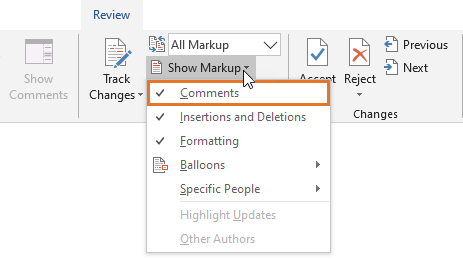
Figure x. To see comments, brand sure that Comments is checked in the Testify Markup carte.
Check 3 – What to do if you only see annotate icons in the balloon area – or how the Testify Comments command works
Read on if you have followed CHECK one and CHECK 2 in a higher place and still tin can't come across comments, or if yous only meet modest comment icons in the balloon area instead of the comment content.
You may have noticed that the Comments group in the Review tab includes a command named Show Comments. You may likewise take noticed that the control is non always enabled and then you can use it – in some situations, the Show Comments is grayed out/disabled. Here is the reason why:
- The Show Comments command is but enabled when Simple Markup is selected. Also, Comments must be checked in the Bear witness Markup menu. See Figures 11A and 11B beneath.
- If Display for Reviewis set up to testify Simple Markup, theShow Commentscontrol toggles betwixt two states:
State 1: Annotate icons are shown in the margin (encounter Figure 12 below)
Country 2: Total comments are shown in the balloon area
NOTE: If comments are not shown beforehand, the first click on Show Commentsvolition switch to state i, i.e. showing comment icons.

Figure 11A. The Show Comments command grayed out. To enable it, y'all must select Elementary Markup instead of any other Display for Review choice.

Effigy 11B. The Bear witness Comments command is only enabled when Simple Markup is selected.
![]()
Effigy 12. Comment icons are shown in the margin ifUnproblematic Markup is selected.
![]()
Figure 13. If you click a annotate icon in the margin, the comment opens in a small window. You can drag the comment window to the position y'all want. Y'all tin also resize the window by dragging an border or corner. To close it, click the X or only click anywhere outside the comment window.
TIP: If annotate icons are shown as illustrated in Figure 12 above, the commented text in the document is not marked in any way. This means that you cannot see precisely what the annotate refers to. However, if y'all hover the mouse over a comment icon, the related comment text is marked. If you happen to hover the mouse over commented text, that text will exist colored and a screen tip with comment data is shown in the same way every bit illustrated in Figure viii above.
A comment plus all replies to the annotate, if whatever, will appear as just ane annotate icon in the margin. When y'all click a comment icon, the first-level comment and all replies to it, if any, will appear in the pocket-sized comment window that opens.
What happens if you copy and paste content that contains comments?
If you copy content in that contains comments and paste the copied content elsewhere, in the same Word document or in some other Word document, the comments will be copied too. The pasted comments will non be linked to the original comments – they proceed the author names, time stamps and content from the original comments but they are independent comments.
If you paste the copied content as plain text, without formatting, the comments will non be included.
How to remove comments in Word
You lot can remove individual comments, one at a time, or remove all comments from a Give-and-take document in one operation. In Word, the term "delete" is used instead of "remove". Therefore, I have used "delete" in the following.
If you delete a annotate that has replies, all replies to the annotate will be deleted too.
If yous delete a reply to a annotate, merely that reply will be deleted.
How to delete a single annotate
- Make certain the comment is displayed. Click in the comment text of the comment to be deleted.
- On the Review tab in the Ribbon, in the Comments group, click Delete > Delete.
Note that the command is disabled if only annotate icons are shown. - Repeat steps 1-2 to delete more comments, if relevant.
How to delete all comments from the certificate
- On the Review tab in the Ribbon, in the Comments group, click Delete > Delete all Comments in Document.
How to delete all comments that are currently visible
Via the Review tab > Tracking group > Show Markup > Specific People, you lot tin can turn off the display of comments and revisions made by specific people. Thereby, simply comments and revisions made by the people checked in the list will be shown in the document.
To delete all comments added by the people currently checked in theSpecific People list:
- On the Review tab in the Ribbon, in the Comments group, click Delete > Delete all Comments Shown.
When y'all delete comments in Give-and-take, the commented text (comment scope) is preserved. Only the comment(s) are removed. This means that the text in the document that the comment(southward) referred to, i.due east. the text that was selected when the annotate(s) were inserted, is still in the document.
Note that theDocTools CommentManager add together-in lets you movement a comment, i.eastward. alter which text the comment is related to. DocTools CommentManager likewise lets you lot select text in the document and convert it to a comment. This will remove the option from the document and insert it in a new comment instead. This is practical in a number of situations. The feature is applied if some comments were originally written every bit part of the document text. It can also be useful, for example, if you want to remove a chunk of text from the document simply keep it for later on use.
How to delete resolved comments
Equally mentioned previously, Word doesn't take a tool specifically for deleting resolved comments. You need to browse through the comments and delete the ones that are marked every bit resolved. Brand sure comments are shown in balloons. You can use the Adjacent orPrevious commands on theReview tab to browse through the comments and delete individual comments equally needed.
How to delete all resolved comments in Word
Equally opposed to Word's ain functionality, the DocTools CommentManageradd-in lets you delete all resolved comments with the click of a push button. You will find a command,Delete All Resolved Comments, for getting rid of all comments that have been marked every bit resolved.
If yous want to review the resolved comments before deleting them, DocTools CommentManageroffers another practical feature. You can use the filter feature in the Review Commentsdialog box to show but resolved comments (type " yes " in the filter field). Yous tin then quickly stride through the resolved comments and use the Delete Comment button to remove the ones you want to get rid of.
How to hide comments in Give-and-take
At that place may be situations where y'all desire comments to remain in a Discussion document merely to exist temporarily hidden. To hide comments (without deleting them), follow one of the methods below.
METHOD i – Hide comments only simply proceed any changes marked equally tracked changes visible
- Select the Review tab in the Ribbon.
- In the Tracking group, remove the check marking from Evidence Markup > Comments.
METHOD 2 – Hide comments and whatsoever tracked changes
- Select the Review tab in the Ribbon.
- In the Tracking group, select Brandish for Review > No Markup.
This will testify the document equally if all comments have been deleted and all revisions accepted.
The comments and revisions are still in the document but subconscious.
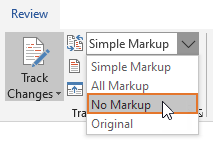
Figure fourteen. Select No Markup to show the document without comments and tracked changes.
Note that in relation to comments, you lot may select Original instead of No Markup since this will also hide comments. Still, in relation to tracked changes, there is a big divergence between the two options:No Markup will show the certificate as if all tracked changes have been accustomed whereas Original will show the document as if all tracked changes have been rejected.
Note that hiding comments and tracked changes only determines how your document is shown right now. The brandish settings are not stored in the document. If you send the certificate to another user, it is that user'due south settings that utilize.
How to print without comments in Discussion
If y'all are going to print a document that has comments, you may want to exit out the comments in the impress. To obtain this, you can follow METHOD 1 or METHOD 2 below.
METHOD one
- Select the Review tab in the Ribbon.
- In the Tracking group > Show Markup, turn off Comments.
If the document also includes tracked changes and if you desire to avoid printing those changes, turn off Insertions and Deletions and Formatting too.
- Select the desired printer and click Print.
- If you lot desire, plough on Review tab > Tracking grouping > Evidence Markup > Comments over again.
METHOD two
- Select File > Print.
- Under Settings, click on the pointer adjacent to Print All Pages (meet (1) in Effigy 15 below).
- Turn offImpress Markup(see (two) in Effigy 15 below).
- Click theImpress button.
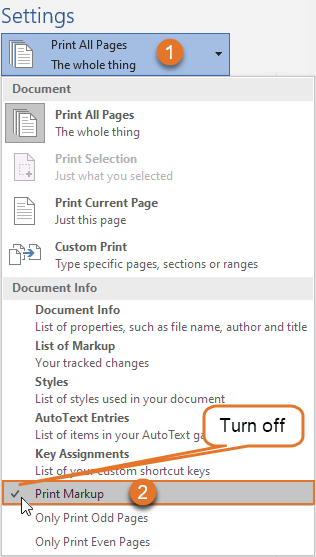
Figure xv. Part of the Print dialog box. To print without comments and other markup, turn off Print Markup.
How to print just the comments in Word
If you desire to print comments simply, without the content of the certificate, follow these steps:
- Select the Review tab in the Ribbon.
- In the Tracking grouping > Testify Markup menu, turnonComments.
If the document includes tracked changes, plow offInsertions and Deletions andFormatting unless you want to also impress those changes. - Select File >Print.
- Nether Settings, click the topmost menu (showsPrint All Pages by default), select Listing of Markup.
- Select the desired printer and clickImpress.
Note that theDocTools CommentManager add-in lets you lot extract comments to either Word or Excel. A printout of an excerpt document will give you a far improve overview of the comments.
How to browse comments in Word
Yous can step through the comments in a Word certificate.
- Select the Review tab in the Ribbon.
- To go to the next comment, click Next in the Comments group
To get to the previous comment, click Previous in the Comments group.
Alternative methods for browsing comments
- You can scan comments from the Navigation Pane (View tab > Navigation Pane > click the search icon > select Comments).
- You can browse comments using the Become To tab in the Find and Supersede dialog box. PressCtrl+G to open the dialog box. In theGo to whatlisting, selectComment. Then use the buttons in the dialog box to scan comments.
How to become an overview of all comments in a Word document
Word does not include a tool that gives you a good overview of all comments. You can browse comments merely you cannot run across all comments at a time.
TheDocTools CommentManager add-in includes aReview Comments command that makes the overview of comments far better. The command opens a dialog box from where you tin can manage all comments in the certificate. The dialog box too lets y'all rank comments by importance.
In improver, DocTools CommentManager lets you extract all comments to a new Word document or an Excel file, including metadata. Yous volition likewise find tools to chop-chop observe a specific annotate in the original source document.
How to change the formatting of comments in Word?
In Word,styles are used to manage the formatting of text. A style in Word is a fix of formatting characteristics that determine font and font size, color, alignment, spacing, etc. In relation to comments, Word uses a set of styles dedicated to comments. You can change the comment styles to change the formatting of comments. Read on below to acquire about the comment styles and how they work.
Comment styles in Discussion
When it comes to comments, Word uses a fix of special styles to format different parts of comments. Word has four built-in styles related to comments:
- Comment Text
- Comment Reference
- Comment Subject field
- Balloon Text
Encounter how to observe the annotate styles names in your version of Give-and-take if it is non English.
In the following, illustrations are used prove and explicate where the different styles are used. Note that in that location are some oddities in relation to the annotate styles – equally y'all will see, not everything works equally expected if modifying the comment styles.
Where are the different annotate styles used?
Used for the comment text typed by users. The style is used both for comments shown in balloons and comments shown in the Reviewing Pane. Run into Figure 16 and Effigy 17 below (cherry-red text).
Used for the initials and number shown in the certificate where a comment is inserted if yous have selected to show all revisions inline. Come across Figure xvi and Figure 18 below (green text).
This manner can be used for a heading in comments and may be intended for that. Note that the style is not automatically applied by Discussion anywhere.
Used for eastward.g. the writer proper name and engagement information in comments and other revisions when shown in balloons. The style is also used for showing text similar Deleted andFormatted + formatting info in relation to tracked changes.
This fashion is just used in balloons and not in the Revision Pane. See Effigy 16 and Effigy 17 below (red text).
How to discover the names of comment styles in non-English versions of Word
The names of comment styles and other built-in styles in Discussion are language-specific. The styles are named in the language of the user-interface of your version of Discussion.
For help on finding the annotate mode names in the language of your version of Word, run across my manufactures:
- Create List of Local Congenital-in Style Names
- Word Style Names in English language, Danish, German language, French
Beneath, you will discover the 4 annotate styles listed with names in English language, Danish, German, and French.
| English | Danish | German | French |
| Comment Text | Kommentartekst | Kommentartext | Commentaire |
| Comment Reference | Kommentarhenvisning | Kommentarzeichen | Marque de commentaire |
| Comment Subject | Kommentaremne | Kommentarthema | Object du commentaire |
| Balloon Text | Markeringsbobletekst | Sprechblasentext | Texte de bulles |
To arrive piece of cake to see where the unlike annotate styles are used by Discussion, I accept modified the comment styles every bit follows before making the illustrations beneath:

Figure sixteen. Illustration of how the comment styles Annotate Text, Comment Reference, and Airship Text have been modified in the examples beneath. The way Comment Subject is not used by Discussion and therefore not included in the illustrations.
In Figure 17 below, comments and revisions have been added and re shown in the balloon area:
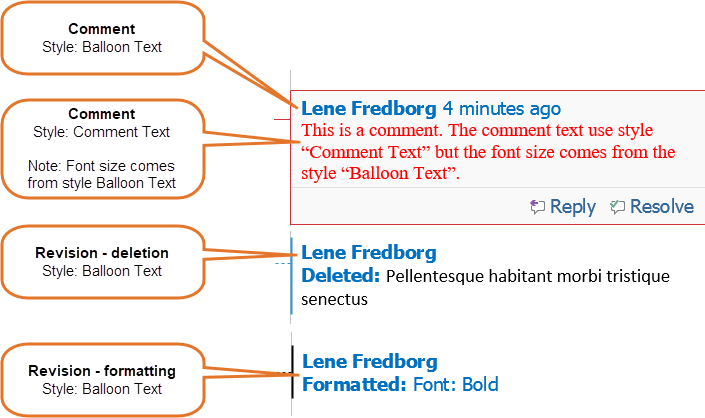
Figure 17. Balloon surface area with examples of comment and revisions. Note that the style Airship Text is used for proper noun, engagement/time info, and revision info. If you lot compare with Figure xvi, y'all tin can see that name and revision info is bold fifty-fifty it the mannerBalloon Textis not divers as bold.
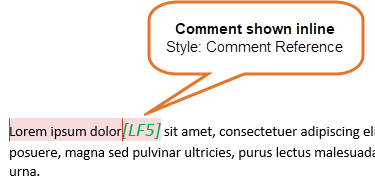
Figure 18. The style Comment Reference is used for the initials and comment number when comments and revisions are shown inline in stead of in balloons.
The shading color on the commented text depends on your setting for markup of comments in theAvant-garde Track Changes Options dialog box.
Acquire more than about the Advanced Runway Changes Options dialog box.
Oddities in relation to annotate styles in Word
Normally, you can change styles in Word to brand them look precisely as you want. Withal, there are some oddities in relation to the comment styles that information technology may be helpful to know almost.
You may experience that some types of modifications y'all brand to a comment fashion don't have whatever issue when comments are shown in balloons. This is virtually likely a result of what Microsoft refers to as "by design". The beliefs isn't e'er logical.
If you examine Figures 17-18 in a higher place and compare them with Figure 16, you will see that:
- If you lot utilise some other font or font color to the comment styles, the changes volition accept issue in comments (i.eastward. normal manner behavior).
- The name and revision information (blue text in Figures 16-eighteen in a higher place) seem to ever be assuming even if the style Balloon Text is not defined equally bold. On the other manus, time information and formatting information announced with the Balloon Text mode in the fashion information technology is defined (run into way data in Figure 16 above).
- As opposed to theBalloon Text style, adding bold to the Annotate Text mode works "commonly", i.east. it the comment text appears assuming or not bold according to the style definition.
- Calculation italic or underline to the manner definitions of Balloon Text andComment Textlikewise works "normally", i.east. information technology makes the corresponding text announced italic/not italic and underlined/non underlined.
- The comment text (crimson in Figures 16-18 above) announced with the font and color defined in the Comment Text style. All the same, the font size of the comment text is determined by the font size defined for the Balloon Text style. Changing the font size of the Comment Text style has no effect. You tin can run across that the comment text in Effigy 17 is larger than in Figure xvi – the font size is inherited from the Airship Text mode. This means that you must alter the mode Balloon Text instead of the styleComment Text if you desire to make the annotate text larger or smaller.
- If you click in the annotate text of a comment and cheque which font size is shown, e.g. in the Font group of the Home tab in the Ribbon, you lot will see that it shows the font size defined in the Comment Text fashion and not the actual font size.
- Well-nigh of the settings you tin apply to styles via the Paragraph dialog box have no effect on the Balloon Text andComment Text styles. Word does non prevent yous from applying indentation, space before, infinite after, etc. Even so, it does not change the mode the comments look. Notation, notwithstanding, that some paragraph settings applied to the style Annotate Text will take consequence if comments are shown in the Reviewing Pane and non in balloons.
- Adding bold, italic or underline to the manner definition ofBalloon Text andAnnotate Textdoes alter the way the comments look.
How to alter the font size of comments in Word by modifying the Airship Text style
As already mentioned in a higher place, the steps to change the font size of comments in Word are non logical. Since it may be i of the changes most users want to brand in relation to the display of comments, I have included the steps with some extra tips here.
As explained higher up, the style Comment Textis used for comment text entered by users. Normally, y'all tin can alter the font size of text by modifying the font size of the style in use. However, this does non work for the Comment Text way.
- To change the font size of comments in Word via styles, you must change the font size in the styleBalloon Text! Irresolute the font size of the styleComment Text has no issue.
I suggest the following steps equally an piece of cake manner to get access to change the Airship Text style:
- Press Ctrl+Shift+S to open the Utilize Styles window.
- In theStyle Name field, type "Balloon Text" (without the quotation marks).
IMPORTANT: In case of a non-English version of Give-and-take, you lot must type the localized style name used in your version of Word instead of "Balloon Text". Encounter the help to a higher place.
- ClickAlter to open up theAlter Style dialog box, showing the current definition of theAirship Text way,
- Alter the font size and make other modifications equally desired. Click OK when finished.
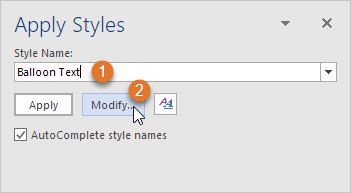
Figure 19. Apply the Apply Styles window to outset modification of the Balloon Text style.
TheDocTools CommentManager add-in gives you easy access to modify any of the annotate styles. DocTools CommentManager lets y'all do everything you tin using Word'south own comment features plus a lot more.
How are the comment styles divers by default?

Figure 20. Instance of Word comment using the comment styles without whatsoever modifications. For details virtually the default comment manner settings, see beneath.
Style: Comment Text
Style type:
Style based on:
Font:
Font size:
Alignment:
Indentation:
Spacing:
Line Spacing:
Linked (paragraph and character)
Normal
Calibri
10 pt
Left
Left 0, Right 0
Before 0 pt, After viii pt (Note: the spading has no issue)
Single
Manner: Comment Reference
Style type:
Font:
Font size:
Character
Default Paragraph Font, i.e. the font in use where the reference is inserted
eight pt
Fashion: Comment Discipline
Style type:
Style based on:
Font:
Font size:
Alignment:
Indentation:
Spacing:
Line Spacing:
Linked (paragraph and character)
Comment Text
Calibri, Assuming
10 pt
Left
Left 0, Right 0
Before 0 pt, After 0 pt
Single
Way: Balloon Text
Style type:
Mode based on:
Font:
Font size:
Alignment:
Indentation:
Spacing:
Line Spacing:
Linked (paragraph and graphic symbol)
Normal
Segoe UI – the font used by default in the user interface of Word
ix pt
Left
Left 0, Right 0
Before 0 pt, After 0 pt
Unmarried
How to remove personal information from comments
There may be situations where you desire to remove personal information similar writer name(s) from comments in a Word document. For case, this may be the example if the Word document is to be shared with external people. Below, you lot volition observe two methods.
METHOD ane – How to remove personal information using the Document Inspector
Word has a built-in feature you may apply. However, the method may remove more information than yous like. See the alert below earlier y'all apply this method.
Alarm
E'er brand sure to relieve a backup copy of your document earlier following the procedure below. The procedure may remove information that cannot exist restored.
The method removes all custom certificate properties and empties the congenital-in properties (Title, Writer, Company, etc.). If your certificate includesDocProperty fields, those fields volition show errors instead of proper results when fields are updated. Notwithstanding, if you lot lock or unlink the DocProperty fields beforehand, you lot can preserve the field results.
If you accept theDocTools DocPropertyManager add-in, yous can export custom document properties earlier removing personal information. Yous can re-import the properties again afterwards, if needed. You can as well import the custom document properties direct from your fill-in copy of the original document. Learn more than about DocTools DocPropertyManager.
To remove personal information from a certificate:
- Select File > Info.
- Click Check for Issues >Audit Certificate. See Figure 21 below.
- In theCertificate Inspector dialog box, plow off all options except Document Backdrop and Personal Information. See Figure 22 below.
- ClickInspect.
- In the next dialog box that opens, clickRemove All. See Figure 23 below.
- ClickClose.
- Salve the document.
Once the certificate has been saved, the writer name in all comments will be changed to "Author" and the initials to "A" if comments are shown inline.
If you insert new comments, you will starting time encounter the actual user name but as before long as you save the certificate, it volition exist replaced by "Writer". On the other mitt, new property values or custom document backdrop you add will remain in the document unless you repeat the steps higher up.
Note that the terms used for author and initials are language-specific and will match the language of your Discussion. For instance, "Forfatter" and "F" will exist used in case of Danish.
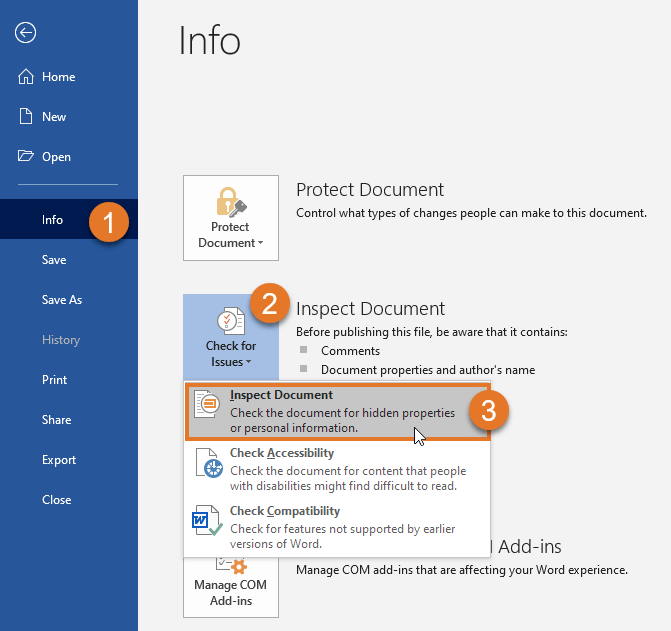
Figure 21. Select File > Info > Check for Issues > Select File > Info > Check for Issues > Inspect Document to open up the Document Inspector dialog box.
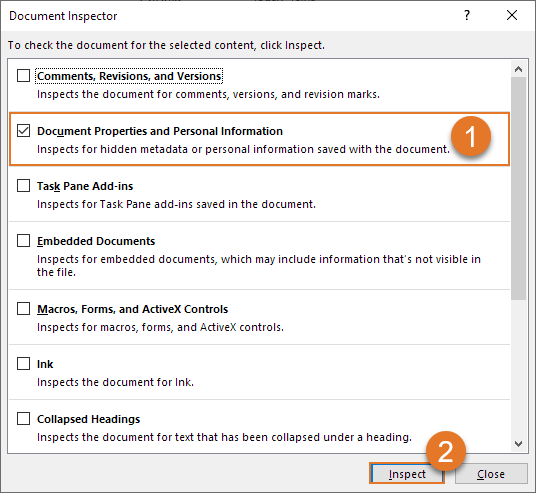
Effigy 22. The Certificate Inspector dialog box. Turn off all options exceptCertificate Backdrop and Personal Information.

Figure 23. Click Remove All in the Certificate Inspector dialog box to remove the data. The author names and initials will non be changed until you salvage the document.
METHOD 2 – How to remove personal information from comments using a macro (VBA)
You can use a macro (VBA) to alter the author name(s) and initials in comments to other values. For example, y'all may want to use neutral values in Give-and-take documents you lot share with external people.
The macro below will handle all comments in the agile document. The macro:
- changes the writer name in all comments to "Neutral Proper name"
- changes the initials in all comments to "NN"
Modify the values in the macro equally desired earlier running the macro.
If you add new comments, you will have to run the macro again to alter them too.
Always make sure to save a fill-in copy of your document before you change the author names.
Sub WordComments_ChangeAuthorNames_AllComments() Dim oComment As Comment 'Iterate through comments 'Replace writer name and initials with "Neutral Name" and "NN" '========================= 'NOTE: Supersede the names below with relevant values '========================= For Each oComment In ActiveDocument.Comments With oComment .Writer = "Neutral Proper noun" .Initial = "NN" End With Next oComment 'Testify message MsgBox "Finished changing author name and initials in " & _ ActiveDocument.Comments.Count & " comments.", _ vbOKOnly, "Modify Author Names in All Comments" End Sub
TheDocTools CommentManager add together-in lets y'all hands change author names and initials in all comments or in only comment by a specific author. For example, you tin can quickly change all writer names to the company proper noun if you are going to share a document with external people.
Numbering of comments in Word
In Word 2010 and before versions, comments shown in the balloon area are numbered sequentially. It is practical to be able to refer to annotate numbers, especially in documents with many comments.
In Word 2013 and subsequently versions, Microsoft has changed the display of comments in balloons. The comments are no longer numbered when shown in balloons. Equally explained above, the style Comment Textis automatically applied to the comment text yous enter. Equally a workaround, y'all may alter the style Comment Text to exist numbered (for help on setting up numbering, come across Shauna Kelly'southward article). All the same, if you add numbers to the Comment Text and write comments with more than than one paragraph, each paragraph will exist numbered and thereby outcome is misleading numbering.
You lot can have sequential comment numbers displayed in the comment references if to display revisions inline in the certificate. Utilize the following settings:
- Review tab > Tracking group > Brandish for Review: All Markup
- Review tab > Tracking group > Prove Markup > Balloons > Show All Revisions Inline
More than options for managing the brandish in balloons
In the Advanced Track Changes Options dialog box, y'all can make further settings for balloons. The dialog box has options for both comments and revisions, i.e. insertions, deletions and formatting changes marked as tracked changes.
How to open the Advanced Track Changes Options dialog box
To open the Avant-garde Track Changes Options dialog box:
- Select the Review tab in the Ribbon.
- Click the dialog box launcher in the Tracking group. Come across Effigy 24 beneath.
This opens theTrack Changes Options dialog box. - Click the Avant-garde Optionspush button to open theAdvanced Runway Changes Options dialog box. Encounter Figure 25 below.
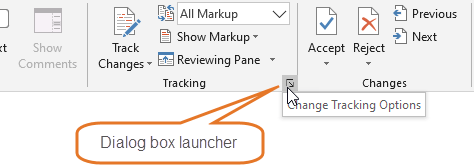
Effigy 24. On the Review tab, click the dialog box launcher in the Tracking group to open the Track Changes Options dialog box.
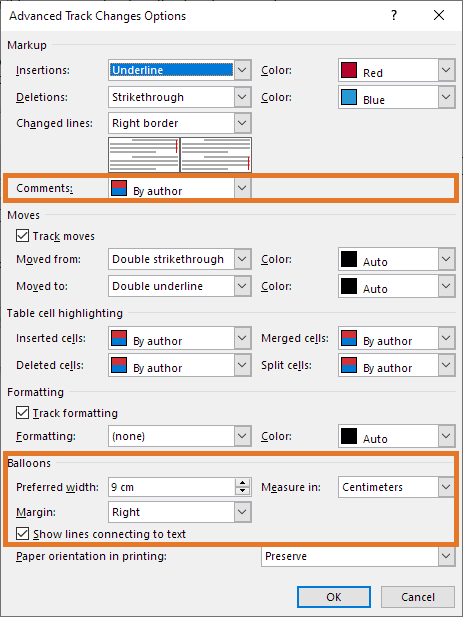
Figure 25. TheAdvanced Track Changes Options dialog box. The colored frames marking the options related to comments. See the descriptions below for details about how the options work.
TheDocTools CommentManager add-in lets you opens the Advanced Track Changes Options more easily. In general, you can exercise everything in relation to comments faster and easier withDocTools CommentManager than you can using Word'due south own comment tools. In addition, the add-in has powerful comment features that are non available elsewhere.
Comments and colors in balloons
See Figure 25 in a higher place, first colored frame.
In the Markupgrouping, the Comments drib-downwardly list lets you select the color to use for comments. Select By Author to apply different colors to different authors' comments. The colors volition be selected by Word and cannot exist defined past you. Up to 20 different colors can exist in utilise. Note that the same author may not e'er be applied the aforementioned color. Select a specific color to use that colour for all comments regardless of the author.
Balloon surface area location and width
See Effigy 25 above, second colored frame.
In the Balloons group, you can define the width of the balloon expanse in the Preferred widthfield and associated Mensurate infield. The width seems to be measured from the position of the vertical bars that are added and to the border of the page. The vertical confined are shown in the left or right side of the page, next to lines that comprise tracked changes.
The Margin pick lets you position the balloons in the left or right side of pages.
The Show lines connecting to text cheque box lets yous turn on/off lines that go from a comment to the commented text (annotate scope) in the document. Annotate lines are dotted but if the selection is in a comment, the related comment connection line volition be a fully drawn line.
Related data
My Give-and-take add-in DocTools CommentManager provides a lot of tools that can aid yous work more efficiently with comments in Word.
This article has explained how add together comments in Word, how to remove comments in Give-and-take, print without comments, change font size of comments and a lot more. I hope this article helps y'all in your hereafter piece of work with comments in Give-and-take.
Source: https://wordaddins.com/support/how-to-add-remove-change-comments-in-word/
Posted by: monroewinget.blogspot.com


0 Response to "How To Add Comments In Track Changes"
Post a Comment